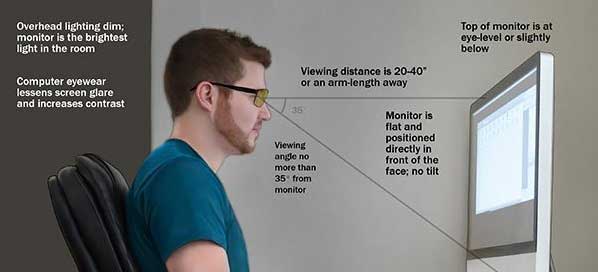
Too light, too dark, doesn’t matter, you need to be like Goldilocks with that sh*t. Here’s what you should be aware of if you want to keep your eyes comfortable, moist, and square-free: The main cause of computer vision syndrome is too many screen hours. When the eye parts flare up, the rest can get stiff, sore, and achy.Īll of that sounds uncomfortable as heck. The muscles that move and focus your eyes are wired into muscles and nerves in your back, neck, and shoulders. This can make your eyes dry out like Joe Rogan’s on 4/20. Your vision goes blurry, and you could even get black spots, floaters (no, not poops, get your mind out of the gutter), or double vision. When your eyes get strained, they don’t work as well.

You’ll know your headache is eye-strain-flavored if it’s concentrated around your eyes. Eye strain headaches are a common computer vision syndrome experience. It can get quite uncomfortable but isn’t usually excruciating. This presents as soreness, discomfort, and pain, or a tingling, burning sensation. Here are the symptoms to watch out for if you’re worried about getting the dreaded square-eyes: That will cause less flickering of the screen.It’s nearly impossible to escape screens these days.Ĭhances are you’ll experience computer vision syndrome at some point, especially if you work in a job that has you staring at a screen all day. That means it will give off less blue light, which is linked to more eyestrain. Lower the color temperature of your screen.It shouldn’t be lighter or darker than your surroundings. You can also make sure your devices are set for eye comfort. You might need to use a different pair of glasses when you’re working on a computer. If you wear contact lenses, give your eyes a break by wearing your glasses.You don’t want your device to be brighter than the surroundings. Make sure the lighting in the room you’re in is bright enough.Try putting a humidifier in the room where you most often use a computer or other device.Use artificial tears to refresh your eyes when they feel dry.Take a longer break of about 15 minutes after every 2 hours you spend on your devices.Follow the 20-20-20 rule: every 20 minutes, look at an object at least 20 feet away for at least 20 seconds.You can find them for all types of computers, phones, and tablets. Cut glare by using a matte screen filter.The center of the screen should be about 10-15 degrees below eye level. Make sure your computer screen is about 25 inches, or an arm's length, away from your face.But a few changes to how you use your devices can be easier on your eyes. No, you don’t have to cut out all screen time. Also, the contrast of text against the background, the glare, and flickering from digital screens can be hard on your eyes. But researchers have found that people blink less than half as often when they’re reading, watching, or playing on a screen. That spreads tears evenly over your eyes, which keeps them from getting dry and irritated. Normally, we blink about 15-20 times a minute. If you change how you use smartphones, computers, tablets, and other screens, you can keep from straining your eyes. If your eyes feel dry and tired, your vision is blurry by the end of the day, or your head, neck, and shoulders ache, all that time with your digital devices might be to blame.

You probably use screens for just about everything - to work, to relax, or just to keep up with daily life.


 0 kommentar(er)
0 kommentar(er)
